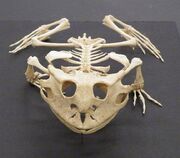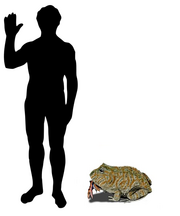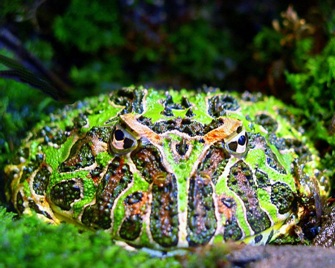Beelzebufo was an extremely large frog native to Madagascar in the Late Cretaceous. It is thought to be the largest frog ever to have existed. Beelzebufo was closely related to, and strongly resembles, the modern pacman frog of South America. Beelzebufo is thought to be large enough to have preyed on small dinosaurs.
Fossil Record[]
Frog fossils in general have been very fragmentary, and Beelzebufo is no exception. Little is known about it, as its fossils are extremely fragmentary, although from them, and from its closest relatives (Pacman frogs) some information has been deduced about it. The first fossil fragments were found in 1993 by David W. Krause of New York's Stony Brook University, but it took 14 years for scientists Susan E. Evans, Marc E. H. Jones, and Krause to assemble enough data for publication in the Proceedings of the National Academy of Sciences, the journal of the United States National Academy of Sciences. Some 75 fossil fragments have been found. Researchers have been able to reconstruct parts of the frog's skeleton, including nearly the entire skull.
Description[]

A pacman frog skeleton, almost identical to the fossils of Beelzebufo.
Beelzebufo was a leptodactylid frog, a member of one of the largest families of frogs, and one that is still thriving today. Amongst the leptodactylids, the frogs closest to Beelzebufo are the pacman frogs (Ceratophrys spp.), and most reconstructions of Beelzebufo are based on them. Like pacman frogs, Beelzebufo would have had a broad, squat body, large eyes placed high on its head, short, stumpy legs, and an enormous mouth. As it is so closely related to the pacman frogs, it is thought to be similar in coloration, so as to blend in with the vegetation and hide from predators and prey. Beelzebufo also possessed well-developed ribs, a feature that is exceedingly rare in modern frogs. Additionally, having short legs, it would likely have been a poor jumper, and moved about in a manner similar to the modern argentine walking toads.
Beelzebufo fossils, when discovered, were thought to be around 40 cm in length from the snout to the cloca (waste disposal and reproductive organ). This would make them the second largest frog ever to exist, after the modern Goliath frog, which can reach 36 cm in length from snout to cloca, and 60 cm in length with the legs outstretched. Recent studies of the fossil skulls, however, have shown that Beelzebufo was likely significantly larger than originally believed, perhaps slightly under 1 metre in length. These upper size estimates, too, seem dubious, as it is believed that a frog that reached such size would be unable to support itself with short legs, like the ones that Beelzebufo possessed.
Diet[]

Size with a human for scale.
Modern pacman frogs feed on mice, lizards, and other amphibians; Beelzebufo would have similarly preyed on mammals, reptiles, or even small and/or juvenile dinosaurs.
Like the modern Pacman frog, Beelzebufo had an enormous mouth and presumably a large stomach to accomadate large food being consumed. It would have hunted in the same way as the modern pacman frogs: finding an ideal spot to camouflage itself, waiting for mammals, small dinosaurs, or other frogs to pass, and then abruptly lunge out, grab the prey, and then use its front legs to shove the prey down its throat. Once in the stomach, the prey would be dissolved by stomach acids in a matter of moments. However, this feeding strategy had its risks. Modern pacman frogs have choked to death on large or armoured prey, as perhaps did Beelzebufo; carnivorous prey such as small theropods could perhaps even eat the frog from the inside.
Locomotion[]
How Beelzebufo moved has been something of a puzzle for scientists. At first, they thought it would move itself about by hopping, like modern bullfrogs and common toads. However, studies of the skull and other fossil fragments that link Beelzebufo to Pacman frogs, combined with the enormous size of the frog, would mean that its short, stubby legs would be useless for performing any kind of long defensive leap to escape from predators. Additionally, Pacman frogs' legs are not positioned far enough to the rear to alow jumping ability. So, it seems extremely unlikely that Beelzebufo could hop effectively.
Another theory was that Beelzebufo would have "walked" by dragging itself along with its short, muscular legs. This study is generally accepted, although it too has recieved criticism. Frogs have thin skin, and it is theorized that if Beelzebufo moved in the manner described above, its belly skin would be sloughed off.
One final theory is that it would move in a semi-erect posture, with its belly raised slightly off of the ground. This theory seems to be more likely than the previous two. It had a ball and socket joint in its legs, allowing them to be swung surprisingly far forward given their short length. There is a modern frog, Melanophryniscus stelzneri, with a similar joint in its leg. M. stelzneri is known as the argentine walking toad; this provides a clue as to how Beelzebufo would have moved. Its front legs would be pigeon-toed (the toes facing inward) while the back feet would be positioned almost directly forward. When walking casually, it would have moved only one leg at a time, patterned front left→back rgiht→front right→back left. However, like the modern argentine walking toad, if pressed, it could probably sprint by alternating between moving its front left and back right and back left and front right legs simultaneously.
thumb|left|Beelzebufo may have moved much like this toad.
